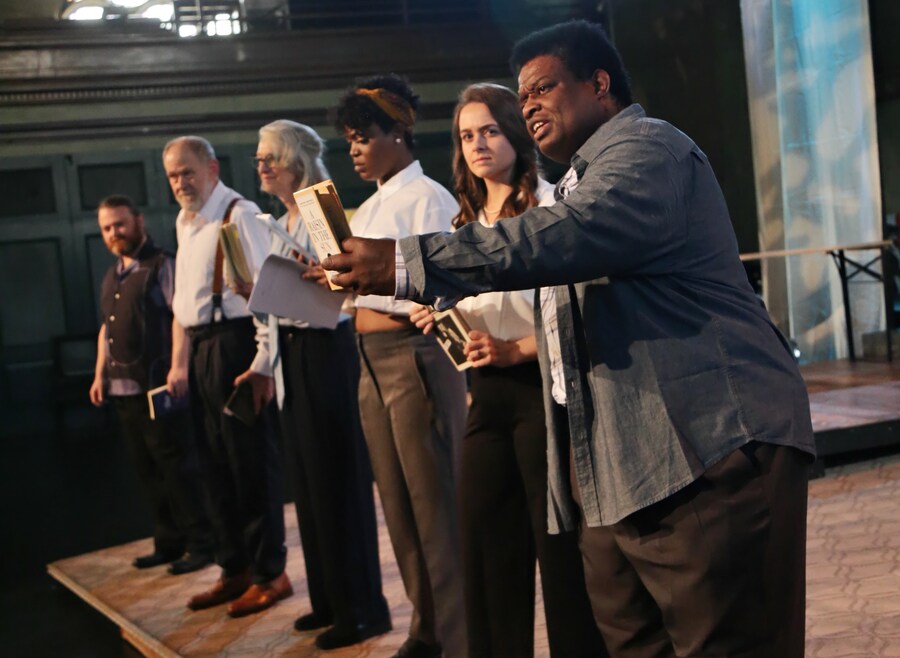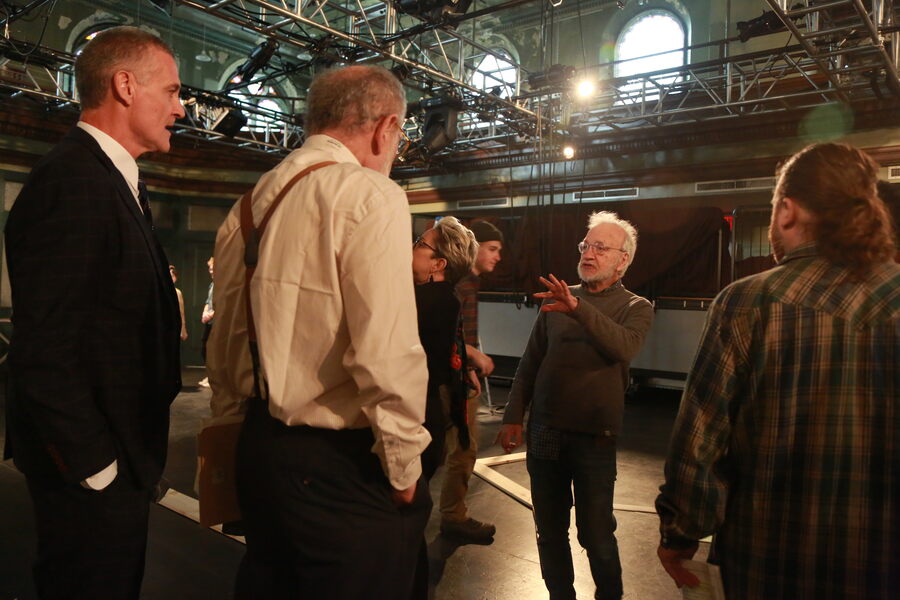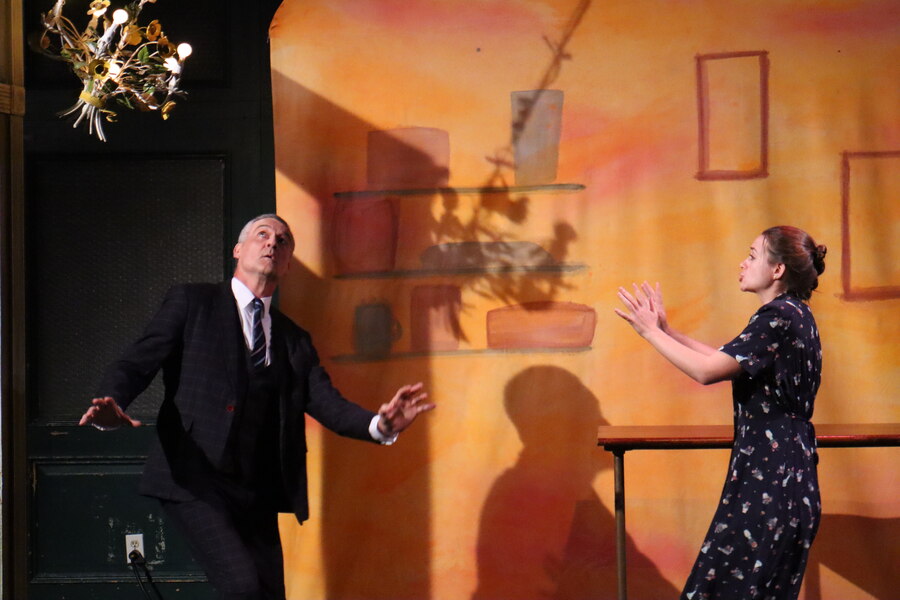On my first visit to Irondale, the company was gathered around a laptop watching old episodes of The Lone Ranger. It was April 2023, and the first preview of Irondale’s new show American Century: Part 1 was 10 days away. You wouldn’t have known it.
“Six Texas Rangers ride alertly across a Western landscape,” intoned the 1949 series’ opening narration, like Uncle Sam giving stage directions. “All are courageous, straight-shooting men.”
“What are you noticing about how they’re using language?” asked Jim Niesen, Irondale’s artistic director, who was also helming American Century. He noted the Ranger’s heavily telegraphed style of performance.
“It’s operatic,” said ensemble member Vicky Gilmore.
After further discussion, they moved into reading a scene from The Count of Monte Cristo, the epic play which famously gave Eugene O’Neill’s father his biggest hit—and his biggest albatross. Nolan Kennedy, an Irondale ensemble member since 2007, read the role of the priest, while Michael-David Gordon (with Irondale since 1992) read the central role of Edmond Dantès. Calling on his deep baritone, Gordon hit on that operatic quality on his final line: “I am the Count of Monte Cristo…and the world is mine.”
“You’ve gotta fill that language,” Gordon explained afterward, comparing the style to Blaxploitation films of the 1970s. “The bodies are so big.”
The scene served as table-setting for American Century: Part 1, a project which would ultimately take Irondale, not unambitiously, through the birth and development of the modern American theatre.
❦
Now celebrating its 40th anniversary, Irondale bills itself as the nation’s “longest standing permanent theatre ensemble.” The company specializes in an intensive research process, devoting weeks of rehearsal time to analyzing texts, films, and music ahead of a new production, through a combination of table work and acting exercises.
Recent projects have included a multi-year exploration of Bertolt Brecht as well as The 1599 Project, which combined four works written by Shakespeare in the year 1599 into a single four-hour epic performed by seven actors.
For American Century: Part 1, they tried something different; in this case the Irondale process itself was the show. Through a medley of songs, scenes and theatre games, the piece sought to trace the birth of 20th century American theatre, drawing a line from Susan Glaspell’s The Verge to Tenessee Williams’s A Streetcar Named Desire to Lorraine Hansberry’s A Raisin in the Sun, with several stops along the way.
“We all stand on so many shoulders,” said Niesen. “The American Century project began with the charge of finding what made these plays work, and how the lessons we learned from Shakespeare and Brecht can be applied to writers like Williams, and Miller, and Hansberry.”

One week later, American Century: Part 1 was in tech. Terry Greiss, executive director and a founding member of Irondale, worked through a monologue from Eugene O’Neill’s Long Day’s Journey Into Night with Niesen.
“That goddamned play,” he said as James Tyrone, who bitterly regrets the way a “money-maker”—The Count of Monte Cristo—has consumed his acting career.
“Do it in a whisper,” instructed Niesen.
“I didn’t want to do anything else,” Greiss-as-Tyrone went on, now softly. “And by the time I woke up—”
Niesen changed tack and prompted, “Do your favorite Shakespeare.”
Greiss paused, thinking for a moment. Then: “O, pardon me, thou bleeding piece of Earth…That I am meek and gentle with these butchers—”
“Great,” Niesen stopped him again. “Now go back to O’Neill. But say it like you said the Shakespeare.”
Later the full company ran the opening, in which the cast lined up and introduced each play we’d hear from that evening.
“Sing this round! Like opera singers!” yelled Niesen.
They don’t miss a beat. “The Frooont Paaage!” “MaachinAAAAAL!”
The cast took turns defining the American Century project for the audience: “How playwriting has grown over the 20th century.” “Understanding where we come from.” “Making theatre out of theatre.” “A company prepares.” This part was left unscripted, with the actors expressing whatever the project meant to them that day.
Music director Sam Day Harmet, readying a musical transition into the next scene, asked for his cue.
“Well, it will be different every night,” said Niesen.
A pause, then, brightly: “Okay!”
“We don’t believe in: ‘This is right, freeze it,’” Gordon explained. “Once you accept that, you sleep a lot better.”
Gordon recalled one evening during the run of Dario Fo’s The Pope and the Witch, which Irondale staged in 2000. When the cast arrived that night, Niesen announced that everyone but the lead would be switching parts.
“It was a great time,” smiled Gordon. “The aliveness is what’s super important.”
Irondale’s approach is not for everyone. New company members don’t always last long. Jacqueline Joncas, a junior member, first worked as a dramaturg and stage manager before joining the acting ensemble. She was still adjusting.
“Sometimes you have to say: ‘What is happening right now?’” she admitted. “But eventually you just figure it out.”
“I grew up with ‘strong and wrong,’ but ‘wrong’ doesn’t even exist here,” she said with a laugh. “Whatever you do, just fucking do it, and don’t hold back.”

Gordon and Shadenia Savid, the ensemble’s newest member, worked through a scene from Raisin. Savid was drawn from Irondale’s program To Protect, Serve and Understand, which brings community members and police officers together to form connections through dialogue and theatre games.
Borrowing a Stanislavski method, Niesen had them do the whole scene without breaking eye contact.
“Independence and then what?” asked Savid as Beneatha, debating Asagai on the future of African countries freeing themselves from colonial rule. (“Eye contact!” yelled Niesen any time they broke for even a moment.) “Don’t you see there isn’t any real progress, Asagai?”
As the actors stalked in circles, the argument became a dance. Unnatural and awkward, it nonetheless teased out the scene’s essential power dynamics. The exercise would go into the final show, with an introduction explaining: “The dance can last as long as you’re not lying.”
Irondale’s projects are always an ongoing process of discovery. Still, with the company’s creative process built into its very form, American Century: Part 1 took this to an extreme. It was the company figuring out what its American Century project was even going to be, false starts included, and the audience was invited to watch them wade through it.
On the night I attended, selections from The Front Page and Machinal felt arch and removed, commenting on the text rather than living it, and a scene from Glaspell’s rarely produced expressionist piece The Verge was strange and beguiling, though it felt unmoored without larger context.
But elsewhere something was unlocked. Performing Streetcar, Gilmore found a heartbreaking emotional clarity in Blanche DuBois’s confession of guilt over her previous husband’s death. And the prescient wisdom of Hansberry’s words was deeply felt in Gordon and Savid’s renditions.
The piece pushed us to think about canonicity in a way not often deeply considered: As the world changed, American drama grew by leaps and bounds, itself finding new forms to confront a changing world.
❦
When I visited rehearsals again in October, Part 2 of the project was underway. Naturally, Niesen had settled on a mammoth challenge: five rarely performed short plays by Tennesse Williams, collectively published as American Blues, performed as a single evening and staged to move through every corner and crevice of Irondale’s cavernous space.
As I arrived, Niesen and the cast were struggling to stage the final section of the last play, Ten Blocks on the Camino Real (later expanded by Williams into a full-length work titled with just those last two words). The play’s last moments include dreamlike appearances from Don Quixote and Sancho Panza, ghostly fiesta dancers, and the deceased protagonist, Kilroy, stealing back his own heart from an autopsy table.
“Go away, Cat!” yelled Esmerelda, a young sex worker who spent the night with Kilroy, here played by Joncas, uninterested in his return from the dead and theft of his own heart.
Niesen cut in. Joncas was saying “Cat” like a name, but it is meant as an insult, he explained.
They ran it again. Jonas hit it harder: “Go away, CAT!”
Niesen flinched, shaking his head. Joncas looked annoyed.

Elsewhere, Greiss struggled to quietly strap on a heavy set of armor for his entrance as Quixote. And Kennedy, Savid, and Gilmore were working on blocking for the doctors’ pursuit of Kilroy after he steals back his own heart. Sensing impending chaos, Barbara Mackenzie Wood, the show’s assistant director and acting coach (also Niesen’s wife and an Irondale co-founder) gathered the cast and led them in a focusing exercise: She asked them to speak the text of the whole sequence aloud, stage directions included, in slow motion.
“Out into space, not in your head,” said Wood. “It’s so easy to go on automatic. It’s exhausting to feel the words every night.”
They read it through. The cast murmured approval at each other’s lines, repeating them back in agreement. Some grounding seeped back in.
“Go away, cat.” Joncas hit it just right. Niesen smiled.
Though Part 2 is otherwise fully staged, with none of Part 1’s meta-theatricality, Niesen will ultimately trust this moment and ditch the coat of armor for Quixote. American Blues will instead conclude with the cast lining up and reading the final moments, as text, exactly as they did here.
❦
Irondale’s projects build upon themselves. The accumulated knowledge and research of one piece will ideally go on to enrich the next.
In the company’s staging of American Blues, which runs at Irondale’s Fort Greene space through November 26, that “aliveness” sought in Part 1 is more keenly felt—particularly in Camino Real. Gilmore is hilariously bizarre as a fortune teller, Joncas soft and soulful as Esmerelda. Greiss brings a haunting sadness to Jacques, the ruined businessman drinking his way toward death.
Niesen’s staging moves fluidly through Irondale’s upstairs space, growing increasingly dreamlike as the audience shuffles from a nightclub to a gypsy psychic’s storefront, the settings ultimately blending together to feel like a single shared purgatory.
The project of American Century will continue, though Niesen isn’t yet sure what comes next. Maybe a Miller play, or perhaps a new work, one drawing inspiration from the classic works the company has excavated. Wherever it heads, the ensemble will keep seeking that aliveness.
“When something lights up, you feel that connection from the difficult rhetoric of Shakespeare all the way through to Williams,” said Niesen. “Sometimes we really hit it.”
Joey Sims (he/him) has written for The Brooklyn Rail, Vulture, Into, Queerty, TheaterMania, New York Theatre Guide and TDF Stages. Joey is an alumnus of the Eugene O’Neill Theater Center’s National Critics Institute and runs a theatre Substack called Transitions.


